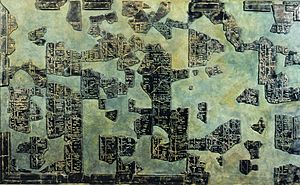Lunisolar calendar facts for kids

A lunisolar calendar is a special kind of calendar that uses both the Moon's cycles and the Sun's yearly path. This means it tries to keep its months aligned with the Moon's phases, while also making sure the year stays in sync with the seasons.
Many cultures around the world have used lunisolar calendars for thousands of years. They are different from solar calendars (like the one most of the world uses today, the Gregorian calendar) which only follow the Sun, and lunar calendars, which only follow the Moon.
Contents
What is a Lunisolar Calendar?
A lunisolar calendar combines two ways of measuring time:
- Lunar months: These are based on the Moon's phases. A lunar month is the time it takes for the Moon to go from one new moon to the next, which is about 29.5 days.
- Solar year: This is based on the Earth's orbit around the Sun, which takes about 365.25 days. The solar year helps us keep track of the seasons.
Because 12 lunar months (about 354 days) are shorter than a solar year (365 days), a lunisolar calendar needs a way to catch up. If it didn't, the seasons would slowly shift and no longer match the calendar dates.
How Do They Work?
To keep the lunar months and solar year in sync, lunisolar calendars add an extra month every few years. This extra month is called an intercalary month or a leap month.
- Imagine you have 12 lunar months in a year. That's about 354 days.
- But a solar year is about 365 days.
- So, after one year, the lunar calendar is about 11 days behind the solar year.
- After three years, it would be about 33 days behind.
- To fix this, an extra 13th month is added to the calendar every two or three years. This "leap month" helps the calendar catch up to the Sun and keeps the seasons in their correct places.
This system makes sure that important events, like harvest festivals or religious holidays, happen at the right time of year, even though the months are based on the Moon.
Why Are They Used?
Lunisolar calendars were very important for ancient societies.
- Agriculture: Knowing the seasons was crucial for farming. Farmers needed to know when to plant and when to harvest. The solar year helped with this.
- Religious and cultural events: Many religious festivals and cultural celebrations were tied to specific moon phases or seasons. A lunisolar calendar helped keep these traditions consistent.
- Navigation: Sailors and travelers often used the Moon and stars for navigation, and a calendar that tracked both was useful.
These calendars allowed people to plan their lives, work, and celebrations effectively by balancing the cycles of both the Moon and the Sun.
Examples of Lunisolar Calendars
Many different cultures have developed and used lunisolar calendars throughout history. Some are still in use today.
The Chinese Calendar
The Chinese calendar is one of the most famous and widely used lunisolar calendars.
- It determines the dates for traditional Chinese holidays, like Chinese New Year.
- Each year in the Chinese calendar is also associated with one of 12 animals of the Chinese zodiac.
- The Chinese calendar uses a complex system to decide when to add an extra month, based on the Sun's position in the sky.
The Hebrew Calendar
The Hebrew calendar is another important lunisolar calendar.
- It is used to determine the dates of Jewish holidays and the weekly Torah portions.
- Like the Chinese calendar, it adds an extra month (called Adar I) seven times in every 19-year cycle to keep it aligned with the solar year.
Other Ancient Calendars
Many other ancient civilizations also used lunisolar calendars:
- The Babylonian calendar was one of the earliest known lunisolar calendars.
- The Hindu calendars in India are also lunisolar, with different regional variations.
- The Buddhist calendar used in many Southeast Asian countries is also lunisolar.
- The ancient Greek calendars were lunisolar, often varying from city-state to city-state.
- The Coligny calendar, found in France, is an example of an ancient Celtic lunisolar calendar.
These calendars show how different cultures found similar solutions to the challenge of tracking both the Moon and the Sun.
Images for kids
-
Record of the Chinese lunisolar calendar for 1834, 1835, and 1836 during the Qing Dynasty under the Daoguang Emperor's Reign (道光十四年,道光十五年,道光十六年)
-
The Five Phases and Four Seasons of the traditional Chinese lunisolar calendar, with English translation.
-
1729 Japanese calendar, which used the Jōkyō calendar procedure, published by Ise Grand Shrine
See also
 In Spanish: Calendario lunisolar para niños
In Spanish: Calendario lunisolar para niños




